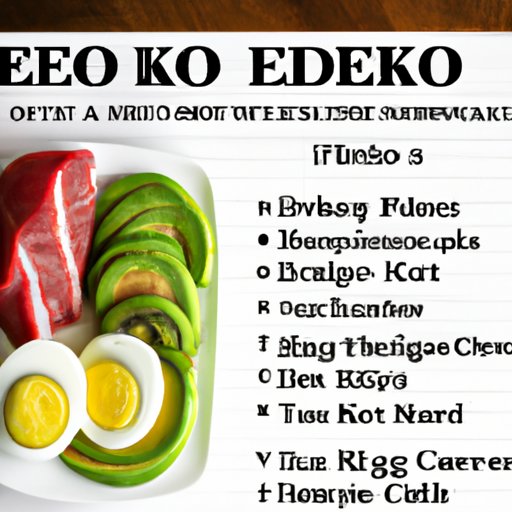
A Beginner’s Guide to the Keto Diet: Everything You Need to Know
Over the past few years, the ketogenic diet has gained immense popularity among people who want to lose weight, improve their overall health, and increase their energy levels. The keto diet involves drastically reducing carbohydrate intake and replacing it with fat so that your body enters ketosis, a metabolic state that promotes weight loss and other health benefits.
However, it can be challenging for beginners to understand the ins and outs of the keto diet, especially when it comes to what foods can and cannot be eaten. In this article, we’ll provide you with a comprehensive beginner’s guide to the keto diet, explaining the types of food you can consume and the science behind how the diet works. We’ll also discuss the importance of meal planning, compare and contrast keto with other popular diets, and provide tips to help you succeed on the keto diet.
A Beginner’s Guide to the Keto Diet: Exploring the Foods You Can and Cannot Eat
The keto diet is a low-carb, high-fat diet that requires you to limit your carbohydrate intake to less than 50 grams per day. By reducing your carb intake, your body enters ketosis, a metabolic state where it turns to fat as its primary source of energy instead of glucose.
On the keto diet, you can consume meat, fish, low-carb vegetables, healthy fats, and dairy products. However, you must avoid foods that are high in carbs, including grains, sugars, fruits, and starchy vegetables. Additionally, processed foods and sugar-laden drinks should be avoided.
It’s essential to focus on consuming foods that are high in healthy fats, such as olive oil, avocado, nuts, and seeds. You should also consume moderate amounts of protein and plenty of low-carb vegetables, such as spinach, broccoli, and cauliflower.
Tracking your macro-nutrients is a crucial part of the keto diet. You need to consume around 75% of your calories from fat, 20% from protein, and 5% from carbohydrates. Using a food diary or a tracking app can be helpful, as it ensures you’re staying within your assigned macro-nutrient ranges each day.
The Science Behind the Keto Diet: Understanding How It Works and Why It’s Effective
When you enter ketosis, your body converts its energy source from glucose to fat by producing ketones. When ketones are present in your bloodstream, they suppress hunger hormones, leading to reduced appetite, which results in weight loss. Additionally, increased ketone levels have been linked to a decrease in seizures in patients with epilepsy and improvements in blood sugar levels and insulin sensitivity in individuals with type 2 diabetes.
However, it’s essential to note that there can be potential risks and side effects associated with following the keto diet. These can include high LDL (bad) cholesterol levels, constipation, and dehydration. Thus, it’s essential to adopt the keto diet under the guidance of a qualified healthcare professional.
Keto Meal Planning: Tips and Tricks to Follow While Grocery Shopping and Cooking
One of the critical aspects of keto success is proper meal planning. When grocery shopping, stick to low-carb, high-fat foods like meat, fish, eggs, nuts, and seeds. You can also include low-carb vegetables like spinach, kale, and lettuce. Avoid carb-heavy foods like grains, sugars, fruits, and starchy vegetables.
Meal prepping is also crucial, as it will ensure you have healthy meals and snacks on hand at all times. You can use batch cooking techniques to prepare your meals in advance. Additionally, incorporating a meal planning app can be a helpful resource that assists with tracking your macro-nutrients.
Some popular keto-friendly recipes include keto bread, pizza, and bacon-wrapped cheese sticks. For snacks, nuts, cheese sticks, and low-carb protein bars are great options.
Keto Diet vs. Other Popular Diets: Understanding the Key Differences
The ketogenic diet is one of several low-carb diets that have become popular in recent years, with others including the Mediterranean and paleo diets. However, there are significant differences between these diets in terms of macro-nutrient ratios, food restrictions, and nutritional benefits.
The Mediterranean diet is a primarily plant-based diet that emphasizes monounsaturated and polyunsaturated fats, vegetables, fruits, whole grains, and legumes. In contrast, the paleo diet restricts dairy, grains, legumes, and processed foods in favor of whole, unprocessed foods.
While the keto diet restricts carbohydrates, it emphasizes fat consumption and moderate protein intake to promote ketosis. The ketogenic diet has similarities with the Atkins diet except that it incorporates more low-carb vegetables, and healthier fat options are encouraged.
Ketosis and the Keto Diet: Breaking Down the Relationship Between Fat, Carbs, and Protein
When you consume a low-carb, high-fat diet, your body enters ketosis, a metabolic state that allows you to burn fat instead of glucose for energy. Consuming adequate amounts of healthy fats is crucial to sustaining ketosis. Fat intake increases fat breakdown in the liver, which produces ketones to supply energy to the body.
It’s important to note that carbohydrate consumption, along with some protein, has the opposite effect on the body and suppresses ketone production to use glucose as fuel. Moreover, excess protein consumption beyond what the body needs to build and repair tissues converts to glucose. This excess glucose isn’t ideal for the keto diet as it leads the body back to glucose-based metabolism.
Conclusion
Before beginning any dietary change or exercise routine, it’s essential to speak with a healthcare professional. This comprehensive beginner’s guide to the keto diet has covered the basics of the diet, including the types of food you can eat, how the diet works, and its benefits and risks. With proper meal planning and dedication, the keto diet can help you achieve your desired weight loss and overall wellness goals.





